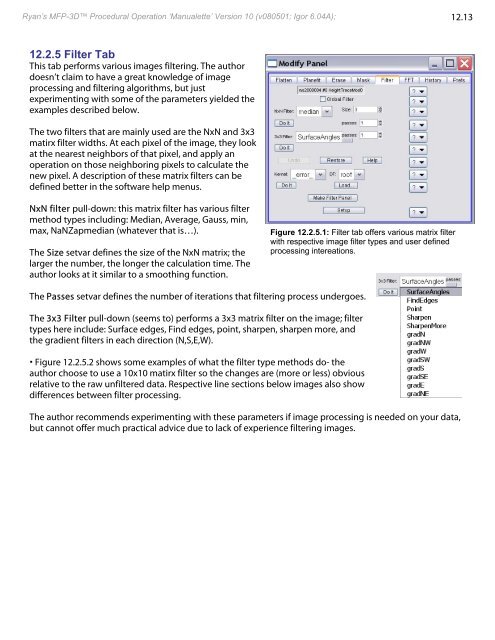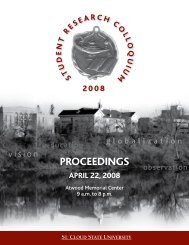B - St. Cloud State University
B - St. Cloud State University
B - St. Cloud State University
You also want an ePaper? Increase the reach of your titles
YUMPU automatically turns print PDFs into web optimized ePapers that Google loves.
Ryan’s MFP-3D Procedural Operation ‘Manualette’ Version 10 (v080501; Igor 6.04A); 12.13<br />
12.2.5 Filter Tab<br />
This tab performs various images filtering. The author<br />
doesn’t claim to have a great knowledge of image<br />
processing and filtering algorithms, but just<br />
experimenting with some of the parameters yielded the<br />
examples described below.<br />
The two filters that are mainly used are the NxN and 3x3<br />
matirx filter widths. At each pixel of the image, they look<br />
at the nearest neighbors of that pixel, and apply an<br />
operation on those neighboring pixels to calculate the<br />
new pixel. A description of these matrix filters can be<br />
defined better in the software help menus.<br />
NxN filter pull-down: this matrix filter has various filter<br />
method types including: Median, Average, Gauss, min,<br />
max, NaNZapmedian (whatever that is…).<br />
The Size setvar defines the size of the NxN matrix; the<br />
larger the number, the longer the calculation time. The<br />
author looks at it similar to a smoothing function.<br />
Figure 12.2.5.1: Filter tab offers various matrix filter<br />
with respective image filter types and user defined<br />
processing intereations.<br />
The Passes setvar defines the number of iterations that filtering process undergoes.<br />
The 3x3 Filter pull-down (seems to) performs a 3x3 matrix filter on the image; filter<br />
types here include: Surface edges, Find edges, point, sharpen, sharpen more, and<br />
the gradient filters in each direction (N,S,E,W).<br />
• Figure 12.2.5.2 shows some examples of what the filter type methods do- the<br />
author choose to use a 10x10 matirx filter so the changes are (more or less) obvious<br />
relative to the raw unfiltered data. Respective line sections below images also show<br />
differences between filter processing.<br />
The author recommends experimenting with these parameters if image processing is needed on your data,<br />
but cannot offer much practical advice due to lack of experience filtering images.
















